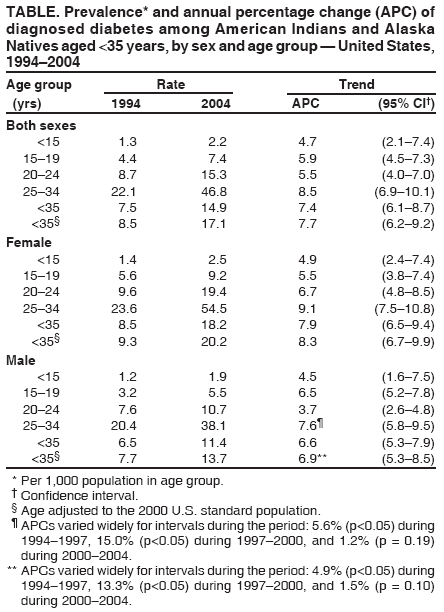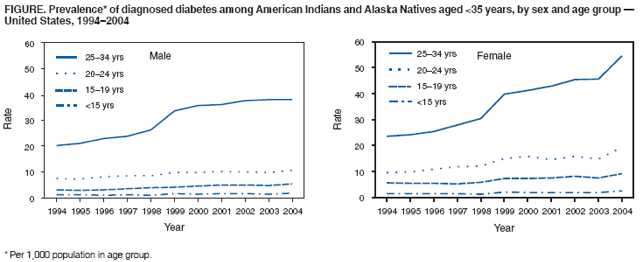 |
|
|
|
|
|
|
|
|
|
|
|
|
|
|
|
|
||||
| ||||||||||
|
|
|
|
Diagnosed Diabetes Among American Indians and Alaska Natives Aged <35 Years --- United States, 1994--2004Diabetes disproportionately affects American Indians/Alaska Natives (AI/ANs) (1,2), and the prevalence of diabetes is increasing among young persons in certain AI/AN populations (3). To examine trends in the prevalence of diagnosed diabetes among AI/ANs aged <35 years, CDC analyzed patient data collected by the Indian Health Service (IHS) during 1994--2004. This report summarizes the results of that analysis, which indicated that the age-adjusted prevalence of diagnosed diabetes increased from 8.5 to 17.1 per 1,000 population among AI/ANs aged <35 years who use IHS health-care services. Because young persons with diabetes have more years of disease and greater risk for costly and disabling complications early in life (4), diabetes prevention programs targeting younger age groups have become increasingly important in AI/AN communities. IHS provides health-care services at its facilities and through tribal and urban Indian health programs; IHS also purchases services through contractual agreements with private providers (5). Approximately 60% of the nearly 3 million AI/ANs residing in the United States live in IHS health-care delivery areas (5). Diabetes cases among AI/ANs aged <35 years were identified using International Classification of Diseases, Ninth Revision, Clinical Modification diagnostic codes 250.0--250.9 from the IHS computerized system for ambulatory patient care for 1994--2004. The ambulatory patient-care database includes unduplicated case reports from patients who visited IHS service units one or more times during each of the years studied. Ambulatory patient-care data were analyzed from 118 of 158 service units; 40 service units (serving approximately 6% of the IHS user population) were excluded because their reported data were incomplete. Prevalence was calculated using the AI/AN population aged <35 years that received IHS health-care services at least once during the preceding 3 years. These overall population data and the number of persons aged <35 years identified in the IHS database as persons with diagnosed diabetes were used to estimate the age-specific prevalence of diagnosed diabetes among AI/ANs in four age groups: <15, 15--19, 20--24, and 25--34 years. Prevalence was age adjusted by the direct method, on the basis of the 2000 U.S. standard population, and average annual percentage changes (APCs) were modeled using regression analysis (6). Results of the analysis indicated that the number of AI/ANs aged <35 years with diabetes diagnosed through IHS health-care services more than doubled from 6,001 in 1994 to 12,313 in 2004. During 1994--2004, prevalence of diagnosed diabetes among AI/ANs aged <35 years increased from an age-adjusted 8.5% per 1,000 to 17.1% per 1,000, increasing by an average of 7.7% per year (Table). Prevalence of diagnosed diabetes increased with age and, in 2004, ranged from 2.2 per 1,000 population among AI/ANs aged <15 years to 46.8 per 1,000 population among those aged 25--34 years. In 2004, the age-adjusted prevalence of diagnosed diabetes was 20.2 per 1,000 among AI/AN females and 13.7 among males (Table). During 1994--2004, prevalence of diagnosed diabetes was greater among females than males in all age groups; prevalence also increased steadily for both sexes and in all age groups, with the exception of males aged 25--34 years (Figure). Among males in this age group, prevalence increased significantly (p<0.05) by an average of 5.6% per year during 1994--1997 and by 15.0% per year during 1997--2000, but did not change significantly during 2000--2004 (Table). Among all age groups, females aged 25--34 years had the greatest APC (9.1%). Reported by: KJ Acton, MD, Div of Diabetes Treatment and Prevention, Indian Health Service. NR Burrows, MPH, J Wang, MPH, LS Geiss, MA, Div of Diabetes Translation, National Center for Chronic Disease Prevention and Health Promotion, CDC. Editorial Note:The findings in this report indicate that, during 1994--2004, the prevalence of diagnosed diabetes doubled among AI/ANs aged <35 years in the IHS health-care delivery system. This increase in diagnosed diabetes might be the result of increased incidence of diabetes (3), increased screening for diabetes, or a combination of both. Screening for diabetes increased in AI/AN communities after implementation in 1997 of the Special Diabetes Program for Indians (SDPI) (7). In partnership and consultation with tribal leadership, IHS provided SDPI grants to create and enhance approximately 400 new diabetes prevention and treatment programs in AI/AN communities in the 35 states that contain the 12 IHS administrative areas. If the increase in diagnosed diabetes described in this report represents an increase in the actual total prevalence (i.e., diagnosed plus undiagnosed) of diabetes among AI/ANs aged <35 years, that would be of particular concern. Earlier onset of diabetes increases the lifetime duration of disease and thus the risk for costly and disabling complications (4). The large increase among young females also is of concern because diabetes is a major cause of congenital anomalies, malformations, and perinatal death in the offspring of young women with diabetes (4). Furthermore, the children of mothers with diabetes during pregnancy might be at increased risk for having diabetes themselves (3). The greater prevalence of diagnosed diabetes among AI/AN females might have resulted from a greater number of health-care visits (e.g., for prenatal care) compared with males (5). Increasing rates of diabetes detected during pregnancy screening (8) might explain why the greatest APC was among females aged 25--34 years. Why the prevalence of diagnosed diabetes among males aged 25--34 years remained level during 2000--2004 is unknown. The findings in this study are subject to at least five limitations. First, the data underestimate the actual prevalence of diabetes because they do not include information on persons with undiagnosed diabetes. Second, outpatient visits for diabetes screening might have been miscoded as diabetes visits, resulting in overestimates of the prevalence of diagnosed diabetes if the screening results were negative. Third, lack of clinical data did not enable distinguishing between type 1 and type 2 diabetes. However, previous studies have determined that, among AI/ANs, diabetes is predominantly type 2 (3,4). Fourth, approximately 6% of persons using IHS health-care services were excluded from this analysis because of incomplete data. Finally, data on diabetes prevalence were not collected for the 40% of the AI/AN population who do not use IHS or tribally operated health-care facilities (5). However, despite these limitations, previous research has indicated that IHS data are sufficiently consistent over time to estimate trends (2). Randomized controlled trials such as the Diabetes Prevention Program (DPP) have determined that lifestyle interventions to reduce weight and increase physical activity can prevent or delay diabetes among adults at risk (9). In 2004, as part of the SDPI, IHS awarded 36 diabetes-prevention demonstration projects to translate DPP findings at the local level. In 2006, in collaboration with IHS, the American Association of Indian Physicians, and other partners, the National Diabetes Education Program (NDEP) distributed the "Move It! And Reduce Your Risk for Diabetes" kit to schools to help increase physical activity among young AI/ANs (available at http://www.ndep.nih.gov/diabetes/aian/moveit.htm). NDEP is a program sponsored by CDC and the National Institutes of Health to promote diabetes prevention and also control strategies for improving the treatment and outcomes of persons with diabetes. In collaboration with IHS, CDC established the Native Diabetes Wellness Program (formerly the National Diabetes Prevention Center) to identify and share culturally relevant and appropriate interventions. One activity of this program was development and dissemination of The Eagle Books series for children, which focuses on physical activity, eating healthy foods, and learning about health and diabetes prevention (available by telephone, 800-CDC-INFO, or e-mail, cdc-info@cdc.gov). Information regarding a related CDC exhibit is available at http://www.cdc.gov/gcc/exhibit/exhibitions_changing.htm. References
Table  Return to top. Figure  Return to top.
Disclaimer All MMWR HTML versions of articles are electronic conversions from ASCII text into HTML. This conversion may have resulted in character translation or format errors in the HTML version. Users should not rely on this HTML document, but are referred to the electronic PDF version and/or the original MMWR paper copy for the official text, figures, and tables. An original paper copy of this issue can be obtained from the Superintendent of Documents, U.S. Government Printing Office (GPO), Washington, DC 20402-9371; telephone: (202) 512-1800. Contact GPO for current prices. **Questions or messages regarding errors in formatting should be addressed to mmwrq@cdc.gov.Date last reviewed: 11/8/2006 |
|||||||||
|